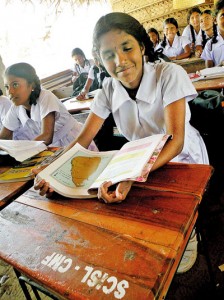Caste in post war North: Education and the global economy
Since the end of the war road connectivity, the increasing presence of finance institutions, tourism and the proliferation of technology have shifted the socio-cultural landscape in the North from insular to being globally connected. A swathe of people across class and castes in the North are in the process of appropriating this global identity by joining Facebook, seeking admission in international schools, (re)using English and accessing consumer goods such as cable television.

File picture of a UNICEF-assisted school in Jaffna in 2009
The ushering in of ‘modernity’ in Jaffna has been matched with a simultaneous diversion from one of Jaffna’s traditional institutions – caste. The aversion to measure caste in Sri Lanka makes it difficult for researchers to piece together a more generalisable account of caste demographics. A qualitative approach (with its limitations of generalisability) has proved invaluable in surfacing caste that continues to shape socio- cultural and political realities in the North (and other regions of Sri Lanka). Nonetheless, one of the generalisations I venture to make is that the rural North is predominantly inhabited by oppressed caste groups. This is fairly common and uncontested knowledge in the North and has been supported by multiple interviews with journalists, civil society, academics and NGOs with knowledge of caste demographics in the North.
My respondents revealed that not only does caste consciousness operate across the Tamil populace in the North but also spills over into active discrimination against oppressed caste groups. Caste discrimination has surfaced in pockets across the North denying or obstructing oppressed caste groups from entering local level authorities, schools and temples. Also, in an increasingly caste conscious and patriarchal society, women from oppressed castes face a double-edged discrimination.
While the global market economy has played a significant role in shaping social relations along class lines, caste dynamics have become more subterranean. A parent from an oppressed caste community in Jaffna commenting on access to schooling in the post war era said: “Now money is everything…if we have money we can hide our caste”. The respondent was acknowledging how wealth and associated class identity had come to matter in gaining school admission. However, the need to ‘hide’ caste implied that caste identity continued to matter. More specifically, an oppressed caste person sought a need to hide their caste identity in fear of being discriminated against.
The initial effort to bring education to oppressed castes was taken on by the Catholic and Anglican missionaries. Since the nationalisation of schools in the early sixties, public education is widely regarded to be the emancipatory tool for marginalised groups – including oppressed castes.
There are a number of public schools spread across both urban centres and rural peripheries in the North that provide free schooling for both urban and rural populations. However, schools in the peripheries suffer from a number of drawbacks including hidden costs, poor access, lack of higher secondary education, fewer teachers and lack of libraries and science labs.
Unfortunately, this period of relative peace has not seen visible improvement in rural education. Crucially, it is oppressed caste groups living in the rural North who are subject to these shortcomings. For example, in the rural district of Achchelu, Kopay DS, a teacher from the local school revealed that a majority of the higher caste children in Atchchelu attend more reputable schools in nearby towns rather than the local school that is attended mostly by children from oppressed castes.
In contrast to efforts on education, the end of the war witnessed a vigorous influx of multiple finance institutions including national banks and private microfinance firms to the North. A credit hungry population has been sucked into easily accessible credit. In the last seven years loaning institutions have managed to reach into the peripheries. Many households I came across in rural parts of Jaffna and Mullaitivu had taken loans from multiple agencies – often to pay back other loans.
Having debt is not peculiar to the North, however, CEPA’s ‘Life and Debt’ study observes that taking on multiple loans and the inability to pay back loans amongst a poverty-stricken population is leading to high indebtedness in the rural North. Keeping in mind that the rural and oppressed caste populations overlap, it is likely that oppressed caste groups will remain in intergenerational debt and poverty traps. This is also likely to reinforce caste hierarchies where poverty (and lack of access to good quality education) will prevent oppressed castes from having a genuine opportunity to be upwardly mobile.
The post war landscape in Jaffna thus illustrates that the traditional caste based inequalities and the ushering in of the modern global market are not at loggerheads but have found a way to co-habit. While a combination of state-sponsored policies and social movements have transformed caste dynamics and subdued the violent streak within caste discrimination; the inequalities compounded by an ailing rural education system and predatory lending institution only reinforce the (historical) injustices borne by oppressed caste groups. (WALK the LINE is a monthly column for the Development Page of the Business Times contributed by CEPA, an independent, Sri Lankan think-tank promoting a better understanding of poverty related development issues. CEPA can be contacted by visiting the website www.cepa.lk or via info@cepa.lk)


